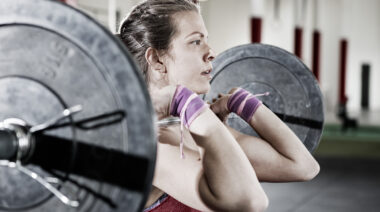No training program is complete without some squat variation. While articles abound about which variation is best, the reality is that the benefits of each are dependent upon who is doing the squatting. There are great results to be had from all the squat variations. Whether you have a barbell behind your neck or in front, or no barbell at all, isn’t really the biggest issue. The most important consideration is the execution, which is completely dependent on intelligent progression.
Unfortunately, this is where the advice usually stops. But today I want to shed some light about how to progress and regress through squat variations to meet your individual needs.
Jumping Straight to Calculus
When most people hear “squat,” they think of a back squat. The back squat is not a very forgiving lift, and our increasingly sedentary population tends to really struggle at executing back squats without a plan that intentionally works up to them. Don’t believe me? Walk into just about any gym and watch the squat rack for an hour. Fair warning: you will be horrified to watch people try to make up for a lack of expertise with excessive volume, load, and heavy metal band bravado.
We’ve all seen the person who lacks enough shoulder external rotation to grip the bar on a back squat. The same guy is also usually the one who also has the core strength of wet noodle. Next thing you know, a metric ton of shear force hits his lumbar spine as he good-mornings the loaded barbell.
In terms of physiological requirements, a good back squat is like calculus, while a goblet squat is arithmetic. Both can be brutally effective when done right, even if the back squat offers the ability to use higher loads. Most people don’t need maximal loads to reach their goals, and you can get very strong with all variations.
Get the Basics Nailed Down First
What’s most important is to spend the time to perfect regressed variations. There is no rushing proper training. Results will not improve by skipping ahead to harder variations. In fact, poor execution yields far less strength and makes injury more likely; injury that will require you to take time away from training.
Instead, start by getting really strong at the most regressed variations. You don’t need chains or bands or any other contraptions, especially in your first few years training. Dan John has trained NFL players using only kettlebell squat variations. Invest the time in learning form, focus, and process, with a constant focus on correct execution and intelligent progression. With a little patience and commitment, you’ll be back squatting on BOSU balls with 360-degree flips in no time. Or something like that.
It should be noted that there is no such thing as perfect form. We all have different anatomy, and at a certain point, it’s time to just go get stronger. However, my experience indicates that more often, people mindlessly focus on the weight on the bar, at the expense of execution. For this reason, I insist upon perfect form, knowing that I won’t get it, but at least I’ll get better execution.
The Squat Progression Sequence
- Wall squat
- Counterbalance squat
- Bodyweight/prisoner squat
- Goblet squat
- Double kettlebell front squat
- Barbell front squat
- Barbell back squat
I first teach the squat using a wall. This tool exposes many of your mobility restrictions, from tight ankles, to hyper-immobility in the thoracic spine. Come back to the wall squat over and over. Perform five sets of five reps on a 3-3-* tempo (three second negative, three second isometric pause, max speed concentric) for homework every night. Use it as active rest between sets every day. This is not for a strength benefit, but has tremendous payoff in neural patterning. The rest of the progressions serve both for patterning and strength and power.
Single Leg Variations
Most of life and almost every sport is played on one leg at a time, so it only makes sense to train that way. You have to progress single leg squat variations too. You can’t just start on a barbell front Bulgarian split squat if you can’t lunge correctly. The typical progression is as follows:
- Split Squats
- Reverse Lunges
- Sled Push
- Bulgarian Split Squats (rear foot elevated)
- Airborne Squats
For both Bulgarian and airborne squats, progress from weightless, to goblet, to barbell front, to barbell back variations. Sled pushes for 20m or less can be worked in at any point, provided the weight is appropriate and allows strict linear drive.
How long you spend in each stage of the progression is entirely dependent on you as an individual. Don’t worry about it. Focus on crushing whatever squat you are doing. After you experience a few weeks of near flawless technique, take the time to ease into a more advanced variation.
Related: The Best Leg Workouts
Troubleshooting Your Squat
Some of my favorite fixes for the squat, other than the wall squat are:
- Blocked Heels: Helps immensely if ankles are tight.
- Banded Knees: Helps glutes fire to promote knees tracking out.
- Slow Down: There is an old adage that speed hides need. Slow tempos and isometric holds develop stability and motor control that promote better quality movement.






